Squirrel Play Behaviour
The subject of play in animals, particularly among adults, is controversial among biologists and ethologists (scientists who study behaviour). While there is broad consensus within the scientific community that play is an important component of childhood, helping to develop hunting/foraging/escape/social skills that will come in handy during adulthood, the subject of play among adults is poorly understood. Indeed, historically play in adults has been considered a functionless behaviour unworthy of study; “behavioural fat” as Dietland Müller-Schwarze and colleagues described it in their study on play behaviour in deer fawns. Consequently, where apparent playful behaviour occurs in adults it can be difficult to ascribe meaning. Furthermore, the old mantra that animals never play for the sake of it, that there’s always an underlying biological imperative at work, is increasingly difficult to reconcile the more we observe other species, including squirrels.
Squirrels are often thought of as playful animals. A quick search of YouTube for “squirrels playing” will bring up a catalogue of videos showing jumping around, “play fighting” and “playing hide and seek” in the trees. In fact, in most cases I have seen, what has actually been captured is mating chases, which can look very similar to what we’d interpret as play behaviour – squirrels chasing one another back and forth through the branches, often with excited “chittering”. In such cases, however, play is far from the object and a female is being pursued by a group of testosterone-fuelled males vying for the lead position that brings with it the chance of mating with her. My intention here is not to cast stones, merely to illustrate that caution is necessary when interpreting behaviour.
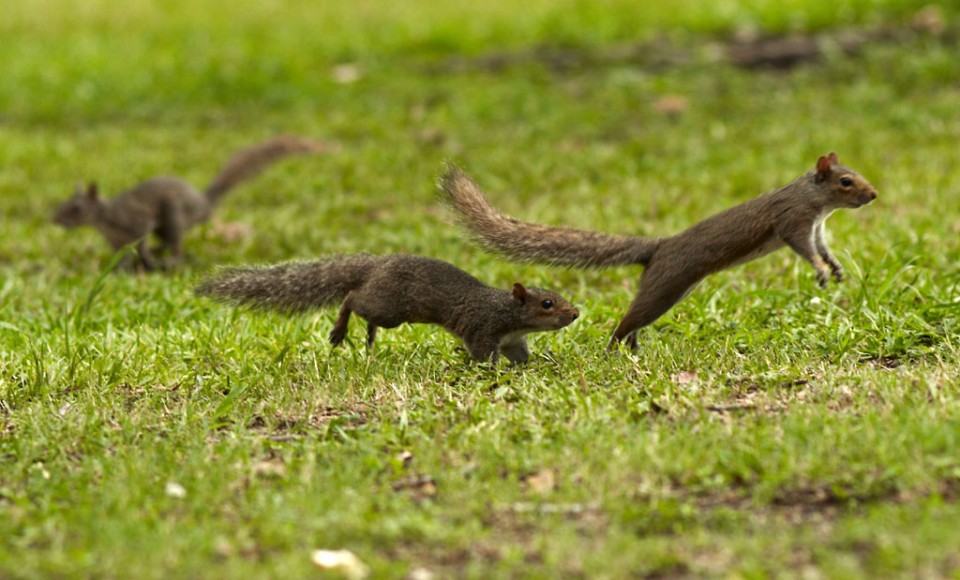
In their answer to the question of whether squirrels play in their Squirrels: The Animal Answer Guide, Richard Thorington Jr. and Katie Ferrell note that, like many mammals, squirrels are playful, although such behaviour is normally restricted to young animals. Thorington Jr. and Ferrell divide the play behaviour observed in squirrels into two classes: solitary play, where an animal will run, climb, jump, twist, tumble and play fight with objects; and social play, during which two or more engage in mock fights (wrestling, chasing, etc.) and mock/pseudo courtship (chasing, mounting and “pretend copulation”). These types of play have been documented in both Red and Grey squirrels.
In his 1987 tome on squirrels, John Gurnell suggests that play biting, chasing, mounting, threat and attack allow the kittens to practice and refine these essential skills for use in later life. University of Idaho biologist John Byers takes this idea a few steps further, drawing amusing parallels with Arnold Schwarzenegger, in his 1998 essay on the biological effects of locomotor play in the Animal Play compendium. Byers argues that play by youngsters is not practice per se, but a critical part of developing their nervous systems, the synaptic links of which continue to be formed after birth. We know that synapses used most during development are retained into adulthood, while less frequently employed ones are lost, so acting out the jumping, manipulation, chasing and fighting skills required in later life may help ensure these axons are retained into adulthood, even if the actions aren’t necessarily carried out in the right sequence.
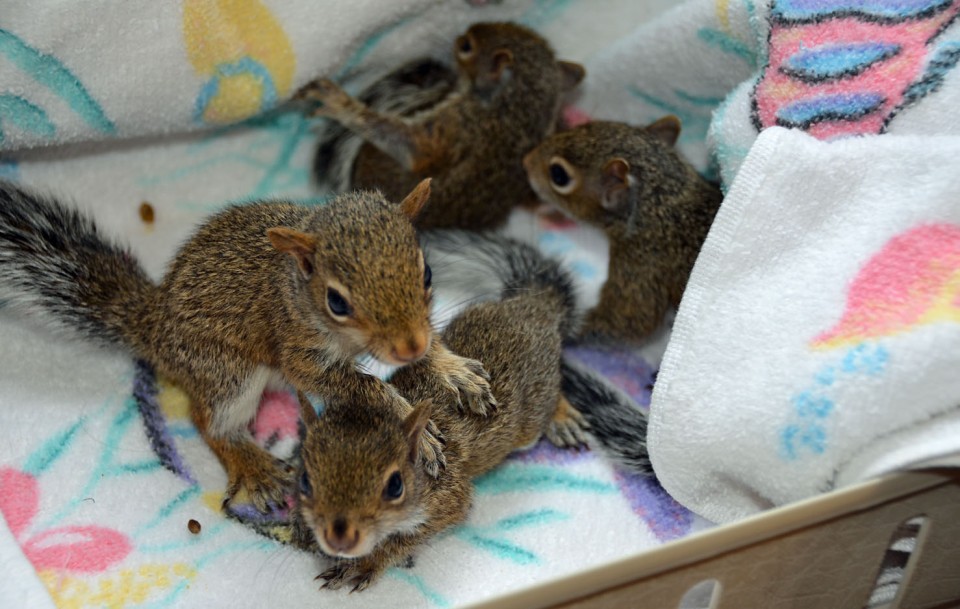
Assuming all observations of mating chases are to be accepted at face value, social play seems predominantly the preserve of young animals. That said, in January 2020 I was contacted by Matt Rogers, a reader in Florida, who described numerous and protracted bouts of play in two adult male Greys, believed to be siblings, that had been visiting his garden for almost a year. Of particular interest in Matt's observations, a segment from his e-mail reproduced below with his permission, is that at least on the pair has been seen trying unsuccessfully to solicit play from other squirrels:
"It's interesting to see them take turns tugging at one another in a type of "king of the hill" activity, but it never gets aggressive and perfectly mirrors the play style of their youth. Interestingly, I've seen 'Darby', reproduce the same type of erratic running and flipping and playing with objects as described in your article. I have even witnessed 'Darby', attempting to play with other squirrels, but they don't seem to recognize the behavior, unlike his sibling."
Matt's observations provide circumstantial evidence that, perhaps as anticipated given our understanding of the behaviour in other animals, play in squirrels is highly individual, with some animals disinterested in engaging, or at least declining play invitations from unrelated squirrels. I would be very interested to hear from any other readers with confirmed observations of social play in adults and particular of adults playing with kittens.
Social play in juvenile Red and Grey squirrels consists mostly of chasing and play fighting, with mock copulation evident from about three months old in Greys. In his 1980 book Squirrels in Britain, Keith Laidler notes pseudo-copulation can be between a male and female or two males:
“In general, [pseudo-copulation] is initiated when a male grabs a female around the waist after leaping towards her in an unusual ‘bouncy’ gait. This bouncing apparently ‘tells’ the female that the other squirrel regards her as a playmate as opposed to a sexual mate. The female assumes an approximation of the copulatory posture, raising her rump, laying her tail over her back, and gripping the ground with her fore paws. The male then grooms the female briefly, leaps again into the air. Regrasps her waist and repeats the procedure. If two males play this ‘game’ the mock-‘female’ will usually roll with his shoulder onto his back and then paw or kick at his playmate in order to get release.”
In the Grey, Laidler describes solitary play as consisting of tumbling, acrobatics and creeping along or around an object, sometimes rubbing the body against it at the same time. Play fighting with an object is also frequently observed, involving the squirrel lying on its back and manipulating the item with its paws, frequently scratching and kicking it. In the case of Red squirrels, as well as play chases involving several kittens, the late Max Planck Institute behaviourist Irenäus Eibl-Eibesfeldt described solitary youngsters kicking away a stick before pouncing on it again to resume play.
I have observed object-play behaviour in both young Red and Grey squirrels and seen videos of adult Greys engaging in solitary object-play; in each case a stick/twig was the toy. Presumably these objects are happened upon by the animal when in a playful mood although some naturalists have inferred, rather speciously I feel, that squirrels may collect objects to play with. In a brief letter to The Countryman, Alan Duncan reported examining an “unusually large” drey and finding a series of unusual objects inside, including a small ball of twine, a child’s leather glove much marked by squirrels’ teeth, several stones, two cigarettes, the stub of a pencil, a ferrule from a walking stick and a well-gnawed bone cigarette-holder. Given that no attempt had been made to incorporate any of these objects into the fabric of the drey, the Duncan concluded that the squirrel “collected them only as playthings”. While their use as toys cannot be ruled out, their acquisition as tooth-grinding objects would seem more likely.
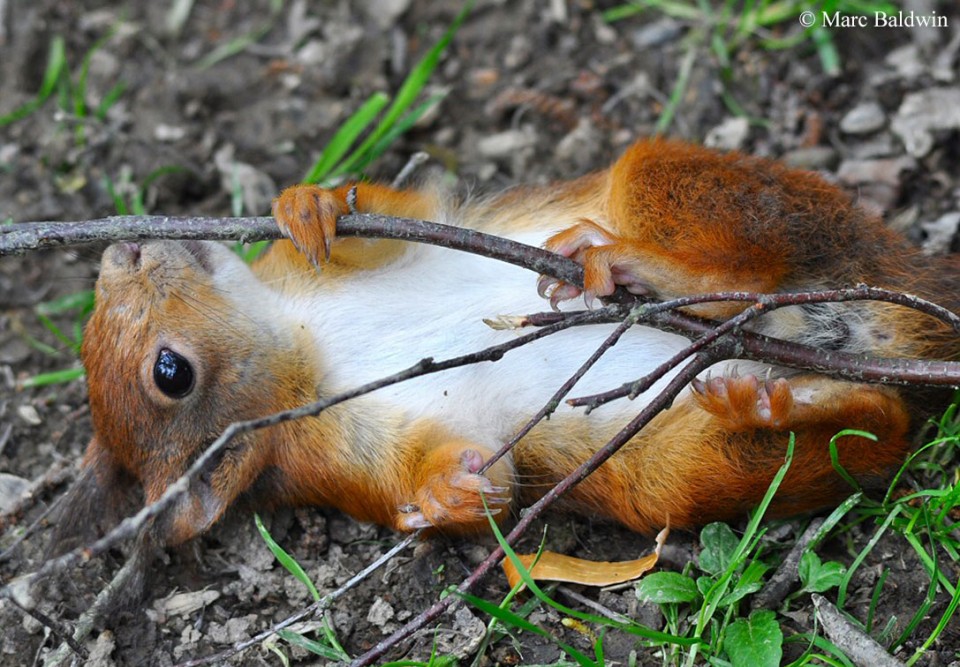
By contrast to social play, solitary play may not be an exclusively juvenile trait and I have come across several reports, many accompanied by video evidence, of what appear to be adult (or at least well-grown subadult) Grey squirrels engaging in erratic jumping, rolling and darting around. Deer biologist Arnold Cooke recently sent me some video footage of squirrels engaging in this behaviour in his Cambridgeshire garden during August 2019. Arnold setup a trail camera at the base of a maple tree in his garden for four days, capturing erratic behaviour on three mornings. Overall, jumping, rolling and darting activity was present in half of the 32 videos captured over the three mornings in at least two different individuals. On one occasion, away from the trailcam, Arnold observed two squirrels engaged in this erratic behaviour simultaneously.
The videos Dr Cooke provided are fascinating as they appear to show adult (or well-grown young) animals engaged in play behaviour that even appears to (briefly) disrupt foraging behaviour. The activity certainly doesn’t match the more deliberate exaggerated actions associated with scent marking – most activity takes place on the grass and there’s also no indication of the bark-stripping or darkening (associated with repeated urination) around the roots that would be expected if the base of the tree was a scent post. Early theories of skin irritation also failed to hold up to scrutiny. No pesticides are applied to the grass or tree and careful inspection around the tree showed no signs of an ants’ nest. Furthermore, as Arnold, who believes this is play behaviour, pointed out:
“In 4 of the 16 erratic videos, they groomed or scratched as if they might have been bitten by something, but this did not occur in any of the 16 non-erratic videos. Also, in a number of videos, they’re showed ‘normal’ behaviour and suddenly became erratic before going back to normal.”
The erratic behaviour in Arnold's garden appeared to end around mid-September 2019 and the resume in mid-April 2020. Conversely, I recorded a brief bout of this behaviour at a study site in Buckinghamshire in late December.
A couple of videos I came across online showing an adult squirrel engaged in similar energetic activity were accompanied by comments suggesting the animal was infected with “bot-fly” larvae. Warble flies lay eggs under the skin of the squirrel from where the larvae hatch out. As the larva grow, they cause intense itching that can result in erratic behaviour in the host. To the best of my knowledge, however, while this is a relatively common parasite in the USA, British squirrels do not suffer with warble flies. Furthermore, late stage infection results in a “lumpy” appearance to the skin and persistent scratching; the animals observed by Cooke did not have any obvious swellings and scratched in only 12% of the videos.
Finally, while they cannot be ruled out without veterinary investigation, such sporadic and short-lived behaviour does not obviously appear to fit with neurological diseases or malnutrition, such as metabolic bone diseases, both of which can also cause twitching and tremors.
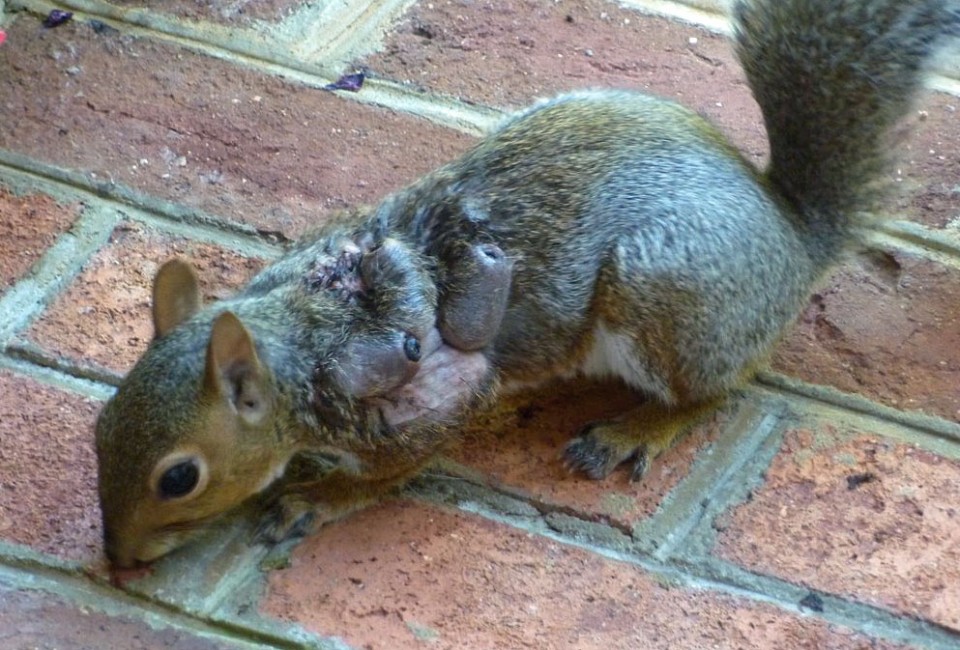
The only similar account of this erratic behaviour I have been able to find in the literature is a description of “false flights” by Keith Laidler, which he posits are a release of sexual energy owing to their frequency peaking during the breeding season:
“This behaviour was interspersed with false flights, in which the squirrel would suddenly drop the play object and race away, zigzagging across the ground or scrambling up a tree for a short distance before returning to recommence object-play.”
Talking to wildlife rehabilitators, many recognise similar behaviour in a variety of species, the young and the “older but young at heart” as one put it, referring to it variously as “funny five minutes”, “mad half hour” or “mad session”. This certainly seems to have close parallels to the erratic behaviour observed in domestic cats (old and young), which I have known to jump up and run around for no apparent reason, and the “binkying” behaviour in domestic rabbits, during which they jump, twist and zigzag, which is widely regarded as an indication of happiness/playfulness. Perhaps play persists into adulthood in some squirrels as it does in these and other species (e.g. stoats, weasels, cows, foxes, etc.).
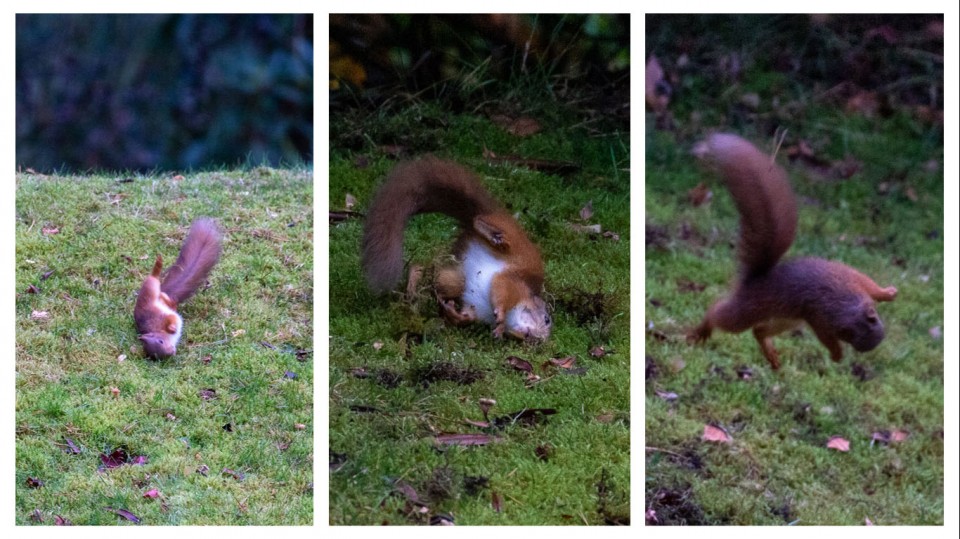
Naturally, it may be the erratic darting off before resuming play Laidler observed signified the squirrel had heard something he (or Arnold’s trail cam) didn’t, causing it to stop playing and flee, returning when the coast was clear. Alternatively, play can make an animal more susceptible to predation and ostensibly part of an evolutionary trade-off of such an absorbing activity could be a built-in “quick release” – the ability to disengage and flee at a moment’s notice. If such a mechanism confers a survival advantage to kittens, perhaps it never fully regresses in adults, accounting for sporadic false flights. Granted, this behaviour may very briefly interfere with foraging behaviour, but this may not represent a selective disadvantage if it happens only occasionally and particularly in parks and gardens where food is relatively abundant.
I can find no reference to similar erratic behaviour in Reds in the literature, but Craig Shuttleworth tells me he has observed this very occasionally and he was recently sent some video footage taken on Anglesey in Wales of a Red engaged in this behaviour. Additionally, in autumn of 2021, Fiona Emslie has observed both adult and juvenile Red squirrels jumping around and sliding down a grassy hill in her garden in Scotland. Fiona considers that this is part of a washing/cleaning behaviour, or the squirrel trying to remove an irritant/parasite, as the activity involved periodic grooming. This seems logical, although it appears quite an exaggerated and energy expensive method, particularly given that squirrels will often spend several minutes sat grooming themselves all over without any acrobatics.